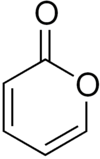Pyrone
Pyrones or pyranones are a class of cyclic chemical compounds. They contain an unsaturated six membered ring containing one oxygen atom and a ketone functional group. There are two isomers denoted as 2-pyrone and 4-pyrone. The 2-pyrone (or α-pyrone) structure is found in nature as part of the coumarin ring system. 4-Pyrone (or γ-pyrone) is found in some natural chemical compounds such as chromone, maltol and kojic acid.
In July 2013 α-pyrones were identified as a new class of signalling molecule in bacterial communication, similar to quorum sensing. Cells with LuxR-type receptors, but lacking its homolog LuxI (and thus unable to produce N-acylhomoserine lactone QS signaling molecules) are known as LuxR "solos", to which pyrones bind as ligands facilitating cell-cell communication.[1]
References
- ↑ Brachmann, Alexander; Brameyer, S.; Kresovic, D.; Hitkova, I.; Kopp, Y.; Manske, C.; Schubert, K.; Bode, H. B.; Heermann, R. (14 July 2013). "Pyrones as bacterial signaling molecules" (PDF). Nature Chemical Biology (Nature Publishing Group). doi:10.1038/nchembio.1295. Retrieved 2015-09-04.
- Streitwieser, Jr., Andrew; Heathcock, Clayton H. Introduction to Organic Chemistry (Third ed.). pp. 1038–1040. ISBN 0-02-418140-4.

